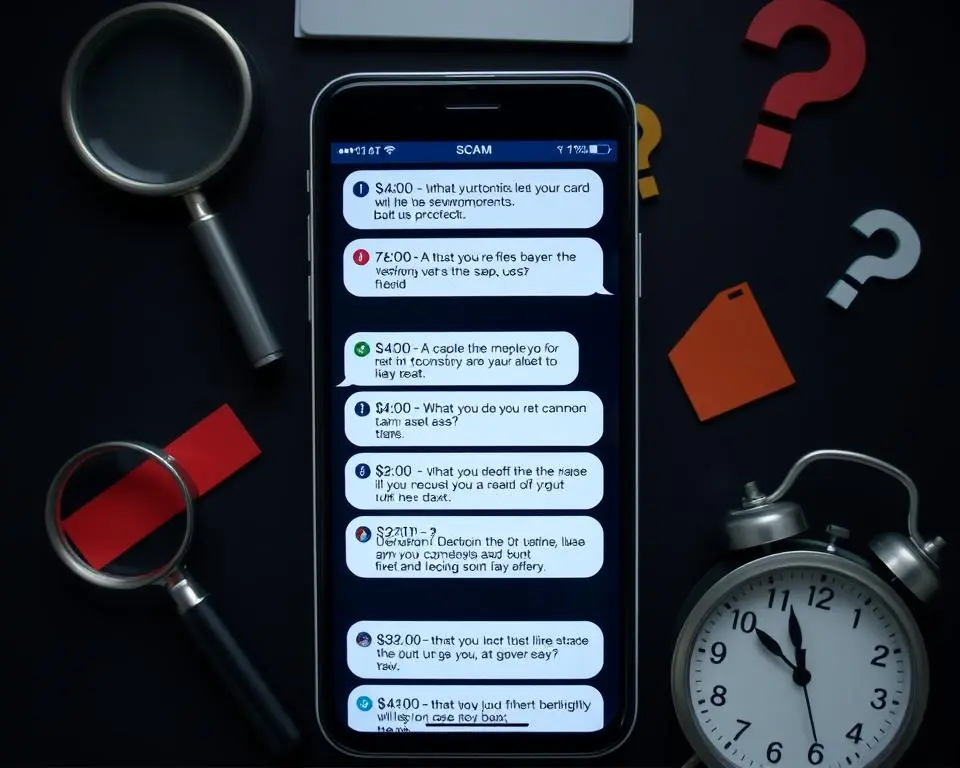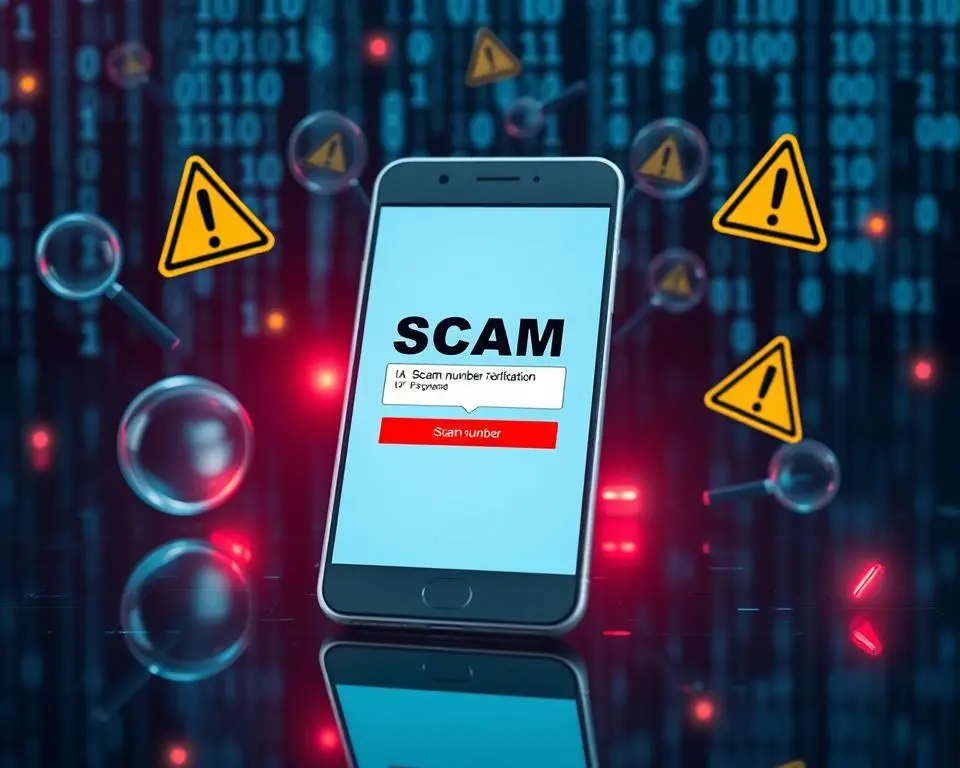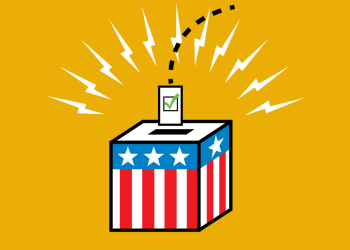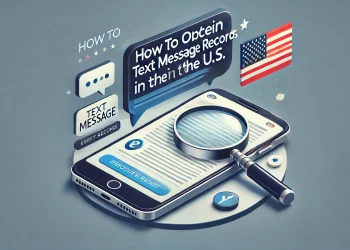Every year, millions of Americans lose billions to text scams. Knowing how to spot a real message from a fake one is crucial. In today’s world, your inbox can be as risky as a dark alley. So, identifying a fake text message is key to keeping your personal and financial info safe.
Scammers are getting smarter, making it hard to tell if a text is a scam. They use fake promises or threats to get a quick response. This digital game is all about exploiting people. With more scams happening, knowing how to tell if a text is spam is vital for staying safe online.

Key Takeaways
- Recognize the scale and impact of text message scams in the U.S.
- Understand why identifying fraudulent text messages is essential to protect oneself.
- Learn tips on distinguishing legitimate communications from possible spam or scams.
- Gain insights into the latest deceptive strategies used by scammers in text messaging.
- Empower yourself with the knowledge to handle and report suspicious text activities proactively.
Recognizing the Red Flags of Text Scams In today’s
world, text scams and phishing are big threats. It’s key to know the signs of these scams to keep your information safe. We’ll look at the common signs of a scam text that should make you suspicious.
Unexpected Requests for Personal Information
Getting a text asking for personal info without warning is a big warning sign. Real compandon’ton’t ask for this info via text. They might ask for passwords, bank numbers, or Social Security numbers, which are scam attempts.
Alarming Messages Prompting Urgent Actions
Scam texts often try to rush you. They might say your account will be closed, and you’ll face legal trouble if you don’t act fast. These messages aim to make you act quickly, which can lead to losing your data.
Too-Good-To-Be-True Offers and Promotions
Scams often promise too much, like free expensive items or big money for a small fee. These messages are clear signs of a scam.
| Scam Type | Common Phrase | Action Urged |
|---|---|---|
| Banking Fr”ud | “Verify your account now to avoid suspense” on.” | Urgent verification of account details |
| Lottery S” am | “CongratulatioYou’veu’ve won $5,000! Click to cl” in.” | Claim prize through a suspicious link |
| Job Offer Fr”ud | “Start earning $500 daily with us today. Apply “ow!” | Application requiring payment of a fee |
Knowing these warning signs and staying alert can help avoid scams. This will keep you safe from spam and text fraud.
Analyzing Suspicious Texts from Unknown Area Codes
It’s essential to watch out for scams today, especially in text messages. Area codes like 626, 628, and 424 have seen more suspicious activiWe’lle’ll look at what these messages might mean and how to deal with them.
When you get a text from the 626 area code, check it’s real, the same goes for texts from 628 and 4Here’sre’s how to check these messages:
- Source Verification: Always check if the text message is from someone you know. If not, you should be careful.
- Message Content: Look at what the message may read the message carefully accurate; it might be a scam.
- Call to Action: Scammers want you to act fast. Be careful if they ask for your personal or financial info.
Being cautious with text messages from unfamiliar area codes is not just about protecting oneself but also about being a responsible digital citizen.
Messages from the 424 area code might be fake promotions. The 626 area code could be pretending to be from a trusted source. And texts from the 628 area code might try to trick you into clicking on links.
| Area Code | Common Scam Type | Recommended Action |
|---|---|---|
| 626 | Institution Impersonation | Verify directly with the institution |
| 628 | Phishing Links | Do not click on unsolicited links |
| 424 | Fake Promotions | Research the offer before engaging |
Scams are getting smarter, so staying informed is key. Remember, real business doesn’t ask for your info in texts.
The Anatomy of a Phishing Scam Text Message Today says the digital world is
Critical to know how phishing scam text messages work. These fake messages look like accurate alerts, like online banking alert texts, to trick people into sharing personal information. It’s essential to be careful and check messages to avoid falling for scams.
Identifying Fake Hyperlinks
Phishing scams often use fake links to trick you. These links might look real but can take you to sites that steal your info. The messages will say you need to act fast, like because of a security issue or a fake transaction.
- Hover over links to preview the URL before clicking
- Compare the URL with the officsite’ste’s link carefully
- Analyze if the URL uses misleading homoglyphs—characters that closely resemble those of legitimate sites
How Scammers Pose as Legitimate Institutions
Scammers try to make you trust them by pretending to be from places you trust, like banks or government agencies. They make their messages look real to trick you. They use words like ‘security alert” or ‘confirmation needed’ to make you act fast without questioning the message.
| Legitimate Message | Phishing Attempt |
|---|---|
| Directs to known URLs | Uses slightly altered URLs |
| Includes specific account detail confirmation | Requests account details to be inputted |
| Secure and standard method of contact | Urgent and unorthodox request method |
Safety Measures for the 626 Area Code Text Message
Scammers are targeting people in the 626 area. It’s essential to know how to stay safe. People share tips on Reddit to help others avoid VM agency scams. Here’s a quick guide to keep you safe from these scams.
- Always check who sent a text before you reply. If it’s from someone you don’t know or asks for personal info, be careful.
- Join local forums like the 626 area code text message Reddit to learn about new scReddit; these places offer tips and news fast.
- Use apps that block screens and texts. They can help keep out numbers with bad reputations.
With more scam texts, there’s a table to help you tell the difference:
| Characteristic | Scam Text | Legitimate TSender’s |
|---|---|---|
| er’s Origin | Unknown or suspicious | Recognizable and verifiable |
| Content Urgency | High urgency demands immediate action | Appropriate, context-specific urgency |
| Request Type | Personal or financial information solicitation | General information, confirmations, or offers void of personal data requests |
Knowing these differences can help you spot scams. Being alert and quick can help you avoid scams.
Understanding the Tactics Behind the VM Agency Scam Text
The vm agency scam text has become a big problem lately. It tricks people with messages that seem urgent. A common trick is to say “ng “we should talk s” on,” making it seem like you need to act fast.
Scammers use many tricks to get people to do risky things. How they work:
- Urgency and Fear: They send messages that “ay “ur”ent” or “immediate attention required”ed.” This makes people act quickly, often without thinking.
- False Pretenses: The messages pretend to be from real agencies or people you know. This makes you feel safe.
- Request for Action: They usually ask you to reply, click a link, or pay money to fix a problem.
Knowing how these scams work can help you avoid them. It’s important to stay alert and not fall for these tricks.
How to Verify the Authenticity of Suspicious Messages
In today’s digital world, scam messages are becoming more common. It’s important to verify the connection text to see if it’s real or a scam. Knowing how to spot these can keep your personal information safe from online threats.

Checking for Message Consistency and Branding
First, check if the message sounds right and matches the company’s style. If it’s from a big company, compare it to their official messages. Look out for wrong logos, fonts, and spelling mistakes. Actual companies keep their brands looking the same, but scammers often get it wrong.
Using Online Tools to Verify Scam Numbers
There are many online tools To figure out if a number is a determined. Tools let you enter a suspicious number and check it against scam databasHere’sre’s a quick look at some popular ones:
| Tool Name | Description | Features |
|---|---|---|
| Scam Number Check | Allows users to input a phone number to ascertain if it has been reported as a scam. | Quick search; reports available instantly. |
| VerifyThisNumber | An online tool offering detailed analysis on whether a number has been involved in scams. | Comprehensive report with scam history, call patterns. |
| Number Trace and r Pro | Tracks phone numbers worldwide to identify fraudulent numbers and call origins. | Geographical tracking, scam likelihood rating. |
Using these tools can help you avoid falling for text scams. Always check the authenticity of messages to keep your online interactions safe.
Steps to Take When You Receive a Spam Text
Getting a spam text can be annoying and even dangerous. It’s a phishing or scam attempt. Texts from the 315 area code or ones that look like they’re from the 332 area code are often spam. Here are some steps to deal with and stop these unwanted messages.
Blocking and Reporting Unwanted Texts
First, block the number when you get a spam text. It doesn’t matter if it’s from the 315 area code or 332 area code. Most phones and carriers let you block numbers right from your messaging app. After blocking, tell your carrier about the scam. This helps stop more messages from coming your way.
- Open the message.
- Select ‘Det’ils’ on sender’ser’s information.
- Tap’on ‘Block this Ca’ler’.
To add security, report the number to places like the Federal Communications Commission (FCC) or the Federal Trade Commission (FTC). They can look into it and try to stop more spam.
Keeping Personal Information Protected
Every spam text, especially from places like the 315 or 332 area codes, is a risk for phishing. Never click on links in these messages, and don’t give out personal info or confirm anything by text.
Never trust urgent or too-good-to-be-true offers that pressure you to act quickly, as these are common tactics in phishing scams.
Stay alert and check if messages are accurate before you interact with them. This helps keep you safe from most scams.
In short, block and report spam texts, and be careful with your ifo. This is key to avoidininformationam and its dangers. Always be on the lookout forAlso, alwayscam tricks, whether they come from the 315 area code or elsewhere.
Dealing with 845 and 844 Area Code Text Message Scams
In recent years, scams using the 845 and 844 area codes have grown. These codes, mainly in New York, are hotspots for fraIt’sIt’s essential to understand these scams to protect ourselves.
The Rising Trend of Scams Targeting Specific Area Codes
Scammers target area codes like 845 and 844 to seem familiar and trustworthy. They pretend to be local services or businesses. This is similar to scams using the 339 area code, showing a pattern of fraud.
Best Practices for Residents Receiving Localized Spam
Residents in these areas can protect themselves with a few steps:
- Verify the Sender: Check the number against known customer service or official websites.
- Please do Not Share Personal Information: Keep personal details safe don’ton’t share them via text.
- Use Spam Filters: Turn on message filters on your phone to block scam texts.
- Report Suspicious Messages: Tell your service provider about suspicious texts to stop future scams.
By following these tips, residents can better defend against spam texts.
| Feature | Benefit |
|---|---|
| Local Area Code Appearance | Creates a false sense of security |
| Crafting Convincing Local Narratives | Increases scam’sam’s success rate |
| Sharing Scam Awareness Tips | Empowers community with knowledge to resist sc” ms |
“Is This a Scam Num” er?” Techniques to Uncover the Truth
When you get a text from an unknown number, like the 628 area code, you might wonder if it’s a scam. Luckily, there are ways to check if a message is authentic and avoid scams.
Start by using online tools that help spot scam numbers. Websites that collect user reports and track scams are beneficial. Just enter the number and see what others have said about it.
Learning from community reports gives you a better understanding of scams. It helps you spot and report them more easily.
Reverse phone lookup services are also excellent. They tell you where the number comes from, which is especially useful for checking whether 628 area code spam text messages are real or not.
- See if the number has been reported as a scam before.
- Find out if the carrier has marked it as suspicious.
- Look for patterns in messages from this number that seem scammy.
Talking to people online can also help. Forums and community boards often share experiences with scam numbers.
| Feature | Benefit |
|---|---|
| User reports on scam numbers | Get quick insights fothers’ers’ experiences. |
| Reverse phone lookup capabilities | Get a detailed background check on suspicious numbers. |
| Community boards participation | Get updates and discussions on new scams fast. |
Using these methods can help you tell real messages from scams. Iprotects your personal infofe from 628 area code spam text messages and other scams. Being careful and using these tools can protect your from scammers’ tricks.
The Rise of the Sarah Text Message Scam and Its Variants
A new scam has become popular among cybercriminals — the Sarah text message scam. It tricks people into sharing personal info or sending money. These messages might warn about fake transactions or ask you to click on harmful links.
Common Phrases and Formats Used in Similar Scams
The Sarah text scam and others use specific phrases to scare or rush you. They might say your account is hacked. You need to act fast, and you’veu’ve won a prize. These messages aim to make you react quickly without thinking.
Scammers also use strange area codes, like 61746, to hide their location. By looking at messages’ stages, you can spot scams more easily in format and words and more often, such as “Falling Victim.”
To avoid scams like the Sarah text message scam, you need to be aware and take steps:
- Scrutinize Any Unsolicited Communication: Be cautious of texts from unknown sources or with strange area codes.
- Do not follow unsolicited LinDon’t ort click on links in suspicious texts. They might lead you to dangerous websites.
- Verify Independently: If a message seems natural, contact the company directly through safe channels.
By following these tips, you follow your chances for these scams.
Protect Yourself from the Latest 484 and 515 Area Code Scam Texts
Scams using the 484 and 515 area codes are common in today’s world. They trick people into giving out personal info or money. Those in these areas need to take steps to keep their info and money safe. We’ll talk about how to protect yourself and what the community is doing to fight these scams.
What to Do If You Live in a Targeted Area Code
If you live in an area often, being alert is key. If it is by scams, being alert is key. Knowledge is the first step. Here are some steps you can take:
- Filter and Block: Use yphone’sne’s built-in features or third-party apps to filter and block messages from unknown senders.
- Verify Independently: Always contact the purported organization using official contact details from their website before responding to suspicious text.
- Report: Forward suspicious texts to your mob carrier’s spam reporting service or local authorities to help them track scam patterns.
Community Awareness and Preventative Measures:
Using community resources and spreading the word about scams is essential. Teaching others how to spot scams can help a lot. This way, we can all stay safer.
| Strategy | Description | Impact |
|---|---|---|
| Community Workshops | Organize local workshops to educate residents about recognizing and avoiding scams. | Increases collective knowledge and preparedness. |
| Local Alerts | Use social media or community bulletins to share updates about recent scam activities. | Keeps the community informed in real-time. |
| Neighborhood Watch Programs | Implement a program that encourages active monitoring and reporting of suspicious activities. | Enhances neighborhood security and cooperation. |
By staying informed and working together, communities in the 484 and 515 areas can fight scam texts better. Being aware and taking action is the best defense against scams.
Conclusion
In today’s world, text messaging is everywhere. But it also brings scams to our phones. This article showed how scammers use texts, especially from 516 and 646 area codes. It taught us how to spot scams and keep our info safe.
Scams use many tricks, from fake links to scary messages. They aim to trick and take advantage of us. To fight back, we must stay alert, check messages carefully, and use tools to protect ourselves.
Stopping text scams is a team effort. We must all be careful and share what we know. By recognizing scams and acting fast, we can stop them. Let’s work together to keep our digital world safe.
FAQ
How can I identify a fake text message?
Look for spelling and grammar errors in fake texts. Also, watch out for generic greetings and urgent messages. Be wary of requests for personal info and suspicious links. Messages from unknown sources are also a red flag.
What are some common warning signs of text scams?
Watch out for messages with links or attachments from unknown senders. Be cautious of texts claiming you won a contest but didn’t enter. Also, be careful of requests to confirm account details or claims of suspicious activity.
Why should I be cautious of texts from unfamiliar area codes?
Scammers often use fake area codes to trick you. They might use different codes to seem local or legitimate. Always be cautious of texts from numbers you don’t recognize.
How do phishing scams via text typically operate?
Phishing scams pretend to be from trusted places like banks or government sources. They try to get you to give out personal info by creating urgency or information ring rewards.
What safety measures can I take against text scams from area code 6
Don’ton’t reply to or click on links from unknown numbers. Use spam blocking tools and verify suspicious texts with real institutions.
How can I recognize the VM Agency scam text?
VM Agency scam texts often mention unknown services or jobs. They usually ask you to contact a rep or click a link.
What should I do to verify the authenticity of suspicious messages?
Check the sender’s information against official sources. Look for message inconsistencies. Avoid hyperlinks and use reverse phone lookup tools.
How should I respond to spam?
Don’t reply to spam texts. Block the number, report it to your carrier, and delete it. Consider reporting it to the Federal Trade Commission.
What are the best practices for dealing with area code targeted text message
code-targeted-tical of unsolicited messages and never sharing personal info? Use area code filters and strengthen your device’s security. Report scams to authorities.
How do I uncover the truth if I suspect a text message is a scam?
Research the phone number online and check forums for similar messages. Use scam identification websites and ask your network provider for help.
What are common phrases used in the Sarah text message scam?
Scammers might ‘ay ‘Hit’sit’s Sarah! I got a new nu’ber”or ‘Is this [Your Na’e]?’. They often ask you to keep talking, leading to requests for money or info.
What should residents do if they live in an area code targeted by scammers?
Send a text alert and tell friends and neighbors about scams. Keep your information private and update passwords often. Watch your accounts for odd activity and use filters and blockers.














